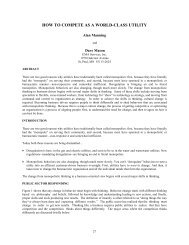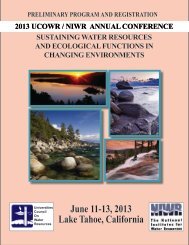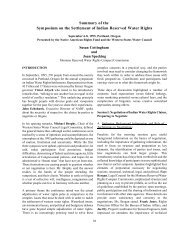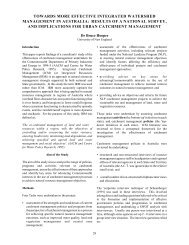28UNIVERSITIES COUNCIL ON WATER RESOURCESJOURNAL OF CONTEMPORARY WATER RESEARCH & EDUCATIONISSUE 135, PAGES 28-35, DECEMBER 2006Exploring the Government, Society, <strong>and</strong> Science Interfacesin Integrated <strong>Water</strong> Resource Management in South AfricaPeter J. Ashton, Anthony R. Turton, <strong>and</strong> Dirk J. RouxCouncil for Scientifi c <strong>and</strong> Industrial <strong>Research</strong>, Natural Resources <strong>and</strong> the Environment, Pretoria, South AfricaMost modern approaches to water resourcemanagement acknowledge that theentire river basin or catchment shouldform the basic management unit if water resourcesare to be managed effectively <strong>and</strong> efficiently. Inaddition, since surface <strong>and</strong> ground water areinextricably linked via the hydrological cycle, it isalso logical for water resource managers to seekto manage all forms <strong>of</strong> water as a single resourcewithin the management unit. These two technicalprinciples form the foundation for integrated waterresource management (IWRM), <strong>and</strong> it is widelyaccepted that if they are implemented effectively,the outcome should be prudent water resourcemanagement within the river basin (Biswas et al.2005).Another important component <strong>of</strong> the IWRMphilosophy is the need to engage all stakeholdersin decision-making processes (Global <strong>Water</strong>Partnership 2000). Indeed, while effective <strong>and</strong>efficient water management institutions areusually regarded as “technocratic,” they rely ongood governance processes to ensure that allgovernment <strong>and</strong> civil society stakeholders areengaged effectively 1 . In its ideal form, therefore,the IWRM approach to catchment or river basinmanagement comprises a guiding philosophy, apractical <strong>and</strong> agreed framework for action, <strong>and</strong> aset <strong>of</strong> desired outcomes. These three characteristicsare inclusive rather than exclusive, therebyreinforcing <strong>and</strong> extending the suite <strong>of</strong> advantagesto be gained from the practical implementation <strong>of</strong>IWRM (Ashton in press).Importantly, very few <strong>of</strong> the stakeholdersor roleplayers that are engaged in technical,social or economic activities within a river basinacknowledge that IWRM decision-making is apolitical process (Allan 2005). In addition, much<strong>of</strong> the IWRM decision-making tends to ignore thesocial, cultural <strong>and</strong> political context, as well as thehistorical aspects within which these are embedded(Ashton in press). Taken together, these processes<strong>and</strong> contexts shape the dimensions <strong>of</strong> governance<strong>and</strong> determine the success or failure <strong>of</strong> IWRMinitiatives. This paper reviews the evidence thatnew <strong>and</strong> more supportive government, society,<strong>and</strong> science interfaces <strong>and</strong> processes are helping toensure the effective allocation <strong>and</strong> management <strong>of</strong>water resources in South Africa.Drivers <strong>of</strong> ChangeIn 1994, the South African government starteda comprehensive process <strong>of</strong> reform throughoutthe water sector; this process will still continuefor several years. The focus for the South Africanwater sector reform is driven by the need to redressthe inequities <strong>of</strong> previous political dispensations,coupled with the urgent need to ensure thatsufficient supplies <strong>of</strong> wholesome water continueto be made available to meet the rapidly growingneeds <strong>of</strong> communities that are fueled by increasedrates <strong>of</strong> urbanization <strong>and</strong> industrialization. Thearid to semi-arid nature <strong>of</strong> much <strong>of</strong> South Africa<strong>and</strong> the growing scarcity <strong>of</strong> water resources makethe resolution <strong>of</strong> these problems particularly acute(Basson et al. 1997).Despite these challenges, South Africa’sNational <strong>Water</strong> Act (Republic <strong>of</strong> South Africa 1998)is widely regarded as one <strong>of</strong> the most progressivepieces <strong>of</strong> environmental legislation in the worldUCOWRJOURNAL OF CONTEMPORARY WATER RESEARCH & EDUCATION
Government, Society, <strong>and</strong> Science in IWRM In South Africa29(Postel <strong>and</strong> Richter 2003). The new <strong>and</strong> enablinglegislative framework presents stakeholders <strong>and</strong>authorities with a clear vision <strong>of</strong> equity, efficiency,<strong>and</strong> sustainability in the allocation <strong>and</strong> use <strong>of</strong>water, as well as the goods <strong>and</strong> services that arederived from or linked to such water use (VanWyk et al. 2006). The focus on greater equitywithin South Africa’s new water policy requiresstakeholders to shift away from rights-based waterallocations to a system where water allocationdecisions are interest-based (Dent 2001). Thismove towards a negotiation-driven process <strong>of</strong>water allocation represents a dramatic change fromprevious procedures, requiring a fundamental shiftin both mindset <strong>and</strong> practice, based on a mutualunderst<strong>and</strong>ing <strong>of</strong> each group’s resource needs <strong>and</strong>preferences, <strong>and</strong> acceptance that these needs aredynamic over space <strong>and</strong> time (Van Wilgen et al.2003).These objectives are ambitious <strong>and</strong> unprecedented<strong>and</strong> it should not come as a surprise that,at this early stage <strong>of</strong> the process, the objectives <strong>of</strong>equity, efficiency, <strong>and</strong> sustainability in the allocation<strong>and</strong> use <strong>of</strong> the country’s water resources remainelusive (Van Wyk et al. 2006). Part <strong>of</strong> the reason forthis lies in the varied interpretations among differentstakeholders as to what constitutes IWRM <strong>and</strong>how its goals <strong>and</strong> objectives can best be achieved.Another, perhaps even more important, reason islinked to the different levels <strong>of</strong> underst<strong>and</strong>ing <strong>of</strong><strong>and</strong> familiarity with the governance processes thatare needed in different situations, <strong>and</strong> how thesecan be best achieved. In South Africa, the shift inmanagement approaches to embrace the principles<strong>of</strong> IWRM has been accompanied by processes <strong>of</strong>institutional decentralization <strong>and</strong> democratizationdesigned to facilitate <strong>and</strong> strengthen localstakeholder participation in decision-making forwater resources management (Pegram et al. 2005).These institutional changes are most easily visiblein the emergence <strong>of</strong> Catchment Councils, <strong>Water</strong>User Associations <strong>and</strong> Catchment ManagementAgencies.Conceptually, the degree to which waterDevelopinginfrastructure(First order focus)Centralized management<strong>Water</strong> is not anEconomic ResourceASupply-sideoptions<strong>Water</strong> is an EconomicResourceBDem<strong>and</strong>-sideoptionsDecentralized management<strong>Water</strong> is a Social <strong>and</strong> anEconomic ResourceCDevelopinginstitutions(Second orderfocus)Figure 1. Conceptual model illustrating the general trend <strong>of</strong> change as the focus <strong>of</strong> water resource managementbroadens to include increasingly decentralized approaches (A), (B) <strong>and</strong> (C), while management options exp<strong>and</strong>from purely supply-side options to include more dem<strong>and</strong>-side options (redrawn from Turton et al., in press).JOURNAL OF CONTEMPORARY WATER RESEARCH & EDUCATIONUCOWR
- Page 3: Journal of ContemporaryWater Resear
- Page 6 and 7: 2Bruce Hooperinstitutional, and tem
- Page 11 and 12: IWRM: Governance, Best Practice, an
- Page 13 and 14: IWRM: Defi nitions and Conceptual M
- Page 15 and 16: IWRM: Defi nitions and Conceptual M
- Page 17 and 18: IWRM: Defi nitions and Conceptual M
- Page 19: IWRM: Defi nitions and Conceptual M
- Page 22 and 23: 18Cardwell. Cole, Cartwright, and M
- Page 24 and 25: 20Mostert26 water boards responsibl
- Page 26 and 27: 22MostertTable 1. Third National Wa
- Page 28 and 29: 24MostertImplementationThe ambitiou
- Page 30 and 31: 26MostertBiswas, A. K. 2004b. Respo
- Page 34 and 35: 30Ashton, Turton, and Rouxresource
- Page 36 and 37: 32Ashton, Turton, and Rouxassumptio
- Page 38 and 39: 34Ashton, Turton, and RouxEffective
- Page 40 and 41: 36UNIVERSITIES COUNCIL ON WATER RES
- Page 42 and 43: 38Hussey and Doversin water policy
- Page 44 and 45: 40Hussey and Dovers1994 Council of
- Page 46 and 47: 42Hussey and Doversestablished Thes
- Page 48 and 49: 44Hussey and DoversTable 1. Typolog
- Page 50 and 51: 46Hussey and Doversassessment appro
- Page 52 and 53: 48Hussey and Doverspolicy goals.Bey
- Page 54 and 55: 50Hussey and DoversFrawley, K. 1994
- Page 56 and 57: 52Mitchelloften took three to four
- Page 58 and 59: 54Mitchelltree preservation plans;
- Page 60 and 61: 56UNIVERSITIES COUNCIL ON WATER RES
- Page 62 and 63: 58Genskow and Borna series of chall
- Page 64 and 65: 60Genskow and BornTable 1. Watershe
- Page 66 and 67: 62Genskow and Bornthe first Dungene
- Page 68 and 69: 64Genskow and BornWashington, DC.Ko
- Page 70 and 71: 66Green and Fernández-BilbaoWithin
- Page 72 and 73: 68Green and Fernández-Bilbaosubjec
- Page 74 and 75: 70Green and Fernández-Bilbaoinflue
- Page 76 and 77: 72Green and Fernández-BilbaoBerbel
- Page 78 and 79: 74UNIVERSITIES COUNCIL ON WATER RES
- Page 80 and 81: 76BallweberEstablish AdvisoryCommit
- Page 82 and 83:
78Ballweberattributes in others (Ch
- Page 84 and 85:
80UNIVERSITIES COUNCIL ON WATER RES
- Page 86 and 87:
82Barreiraand ground water. To this
- Page 88 and 89:
84Barreirawith other states for int
- Page 90 and 91:
86UNIVERSITIES COUNCIL ON WATER RES
- Page 92 and 93:
88Davis and ThrelfallResource Manag
- Page 94 and 95:
90Davis and ThrelfallTable 2. Thirt
- Page 96 and 97:
92Davis and Threlfallby regional an
- Page 98 and 99:
94Davis and Threlfallenforcement, a
- Page 100 and 101:
96Davis and Threlfallhusbandry prac
- Page 102 and 103:
98Davis and ThrelfallNew Zealand: T
- Page 104 and 105:
100UNIVERSITIES COUNCIL ON WATER RE
- Page 106 and 107:
102Lamoree and van SteenbergenIt is
- Page 108 and 109:
104Lamoree and van Steenbergenand n
- Page 110 and 111:
106Lamoree and van Steenbergeninter
- Page 112 and 113:
108BourgetWorks Planner Capability
- Page 114 and 115:
110Bourgetwith over 600 people resp
- Page 116 and 117:
112Bourgetgovernment’s intrusion
- Page 118 and 119:
114Bourget4.management, drought man
- Page 120 and 121:
116McKayFigure 1. The four paradigm
- Page 122 and 123:
118McKay4. Paradigm 4 (which commen
- Page 124 and 125:
120McKaythree main functions:1. ass
- Page 126 and 127:
122McKayState Implementation of the
- Page 128 and 129:
124McKayTable 2. Corporate governan
- Page 130 and 131:
126McKayFigure 4. Qu. 26 - The ESD
- Page 132 and 133:
128McKayFigure 7. Qu.93- This organ
- Page 134 and 135:
130McKayBrundtland Report. 1987. Ou
- Page 136 and 137:
132UCOWR BOARD OF DIRECTORS/COMMITT
- Page 138 and 139:
134BENEFITS OF UCOWR MEMBERSHIPThe
- Page 140 and 141:
136Past Issues of the Journal of Co
- Page 142 and 143:
138Academic Organizations Membershi
- Page 144 and 145:
140Individual Membership Applicatio
- Page 146 and 147:
Universities Council on Water Resou
- Page 148:
Integrated Water Resources Manageme








